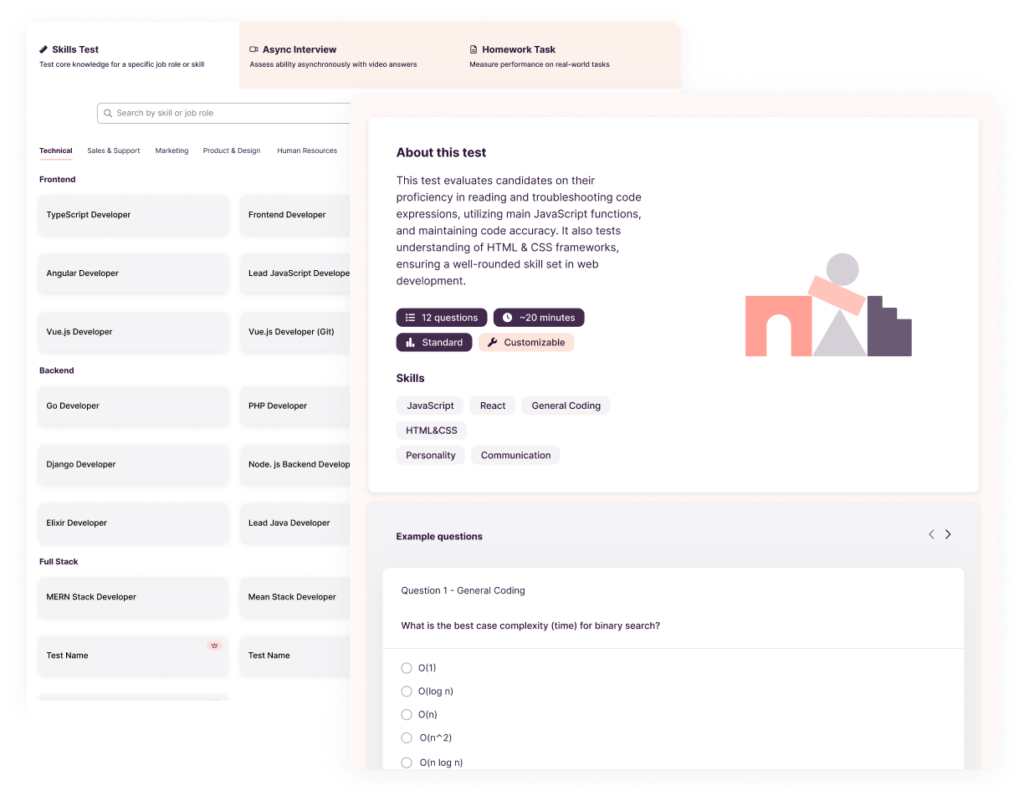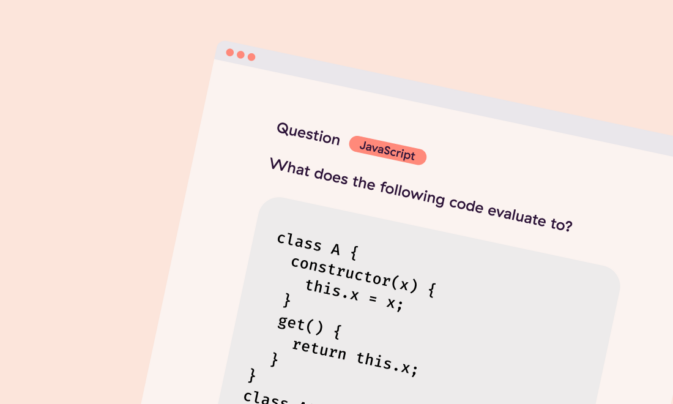Recruiters like you can invest hours into the hiring process, only to be left with candidates who have the wrong skills, mismatched competencies, and are a poor cultural fit. That is…less than ideal.
Skills assessment tests improve hiring success by allowing candidates to practically demonstrate their skill sets, personality traits, and real-life job performance. 2023 saw a 27% rise in companies using assessment tools to find the best candidates, so if you’re new to skills assessments, let us catch you up.
By the end of this article, you’ll discover everything there is to know about skills assessment tests, including what they are, the different types on offer, and why they’re waaay better than traditional hiring techniques.
We’ll also explore how Toggl Hire can seamlessly integrate candidate-friendly skills assessments directly into your end-to-end recruitment process.
TL;DR—Key Takeaways
- Skills assessment tests evaluate whether a candidate’s abilities, aptitudes, competencies, and personality traits align with a particular job role.
- Skills assessment tests make recruiter’s lives easier by combining pre-built templates, business-specific customization, automated evaluation, and end-to-end ATS integration.
- Many types of skills tests are available, including soft skills tests, technical skills assessments, cognitive ability tests, and personality assessments.
- Skills assessment tests are more objective, reliable, and professional than traditional hiring methods and are proven to be far more engaging and accessible for candidates.
- Toggl Hire is the only full-cycle hiring platform that’s purpose-built for skills-based hiring, and you can get started for free today!

What are skills assessment tests?
Skills assessment tests are tools used to evaluate whether a candidate’s abilities, aptitudes, competencies, and personality traits align with a particular job role.
They provide a user-friendly way for candidates to practically demonstrate any skills applicable to the job they’re applying for.
Unlike resumes, which can include any number of AI-generated lies, skills tests offer a scientific way to measure a candidate’s suitability and provide the best indication of their performance in the work environment.
They also level the recruitment playing field. Multiple-choice and case study-style questions provide more inclusive ways for candidates to demonstrate the necessary skills, and data-driven results fairly benchmark and compare candidates while removing hiring bias.
All of this combines to help talent acquisition professionals make objective hiring decisions, reduce the chance of making a costly bad hire, and improve hiring manager satisfaction.
How pre-employment assessment works
Whether it’s a software development, marketing, or finance vacancy, setting up and running a skills test is straightforward. Let’s take a look at the step-by-step process.
- Identify key skills related to the job: Before pushing your vacancy into the job market, you must set strong foundations by identifying the specific skills, skill levels (e.g., entry-level vs. expert), competencies, and personality traits needed for the role.
- Create the first draft of your tests: Once defined, you can create the first draft of your skills tests. Tools like Toggl Hire include easy-to-use templates and an expert-curated question library to quickly build a skills test that’s perfect for your role.
- Sprinkle in business-specific input: To make your skills test extra specific, we’d recommend some business-specific questions or context to enhance the experience. Often, this comes from current employees or the hiring managers themselves.
- Signpost candidates at the right stage of the hiring process: Once created, begin signposting candidates to take your newly created skills test. Recruiters often use this in place of or directly after a CV review in their hiring process.
- Evaluate your candidates: As the results start rolling in, evaluate them to decide who to progress. This can be a lot of work if you have a high volume of job candidates, which is why Toggl Hire can automatically grade every skills test, progressing or rejecting candidates based on a pre-defined pass threshold.
- Progress candidates to the next stage: With your shortlist of candidates, progress them to the next stage of your hiring process, whether that’s a job interview, personality assessment, or trial task.

Types of skills assessment tests
Depending on your objectives, the hiring stage, and the role, you can use different skills assessment tests to get the best results. Let’s look at the most common types of pre-employment testing, including their key characteristics and real-life skills test examples from Toggl Hire.
Soft skills tests
Soft skills are non-technical skills people use in the workplace to communicate, collaborate, solve problems, manage work and relationships, and more.
These kinds of skills are critical to every job, as they show how candidates work with others and lead teams through difficult situations. Soft skills assessment tests are common in the early to middle stages of the recruitment process.
Our time management, communication, and teamwork tests are great for gauging a candidate’s soft skills.
Hard skills tests
Hard skills are the technical, role-specific skills employees need to do their jobs. In many instances, they can be tangibly measured against a particular benchmark or standard. Common examples include software coding, languages, and technical writing.
Hiring teams often test hard skills in the middle to later stages of the recruitment process, either through a dedicated skills test or a practical case study scenario.
Toggl Hire’s role-specific tests for technical writers or information security analysts are great for testing sets of hard skills in a way that accurately predicts real-life job performance.

Technical skills tests
Technical skills extend hard skills testing by focusing on a candidate’s ability to use a specific software or specialized tool. These aptitude tests are popular in technical industries, such as IT, engineering, graphic design, and healthcare, where it’s important candidates have experience with particular business-critical systems.
Again, these are common in the middle to later stages of the recruitment process and may involve case studies or trial tasks to test a candidate’s ability.
Our Microsoft Excel, Graphic Designer (Photoshop), and Google Ads Specialist tests are good examples of application-specific technical skills assessments.
Cognitive ability tests
Cognitive skills are the mental abilities enabling people to process information, learn new things, and solve problems. They’re also known as thinking or intellectual skills and include reasoning, memory, decision-making, and problem-solving.
At times, you’ll also see these referred to as situational judgment tests. Regardless of what you call them, though, cognitive ability tests are often combined with soft skills assessments at the beginning to middle of the hiring process.
Our cognitive ability test is one of our most popular Toggl Hire tests, covering everything from attention to detail to how candidates learn new skills.
Personality tests
Personality tests are similar to psychometric tests or popular tests such as the Big Five or 16 Personalities. They measure different attributes such as character, behavior, emotions, traits, and values.
While we don’t recommend relying solely on personality tests during hiring, you can use them to learn more about a candidate and gauge if their personality fits the company culture, team, and job role.
Depending on the role, personality tests may be used at different parts of the hiring process or included as part of another test, such as our leadership & management test.
Skills tests vs. traditional hiring: What are the benefits?
Now you know what skills tests are, why should you use them ahead of traditional resumes and interviews? Let’s take a look at some key benefits of using skills tests:
- Skills tests are objective. Skills tests remove human bias and ‘gut feel’ replacing them with tangible, data-driven insights into a candidate’s abilities. This provides objective hiring decisions and reduces the chance of a bad hire.
- Skills tests are efficient. Create one skills test and invite several candidates to apply. No more cramming interviews into the 9-5 as you can take skills tests at any time without being around to monitor them.
- Skills tests are automated. Recruiters’ time gets swallowed up sifting through hundreds of CVs. Instead, skills tests automatically mark candidate responses, automating rejections and progressions to leave you with a filtered list of high performers.
- Skills tests are better predictors. What better way to predict how someone will perform in a role than asking them to practically prove it? When candidates demonstrate their skills in a simulated environment, it gives you and the hiring manager confidence in their real-life job performance.

When should you use skills tests during the hiring process?
Skills tests are versatile. Recruiters can use them at any point in the hiring process to deliver exact insights about candidates. Typically, you can use skills tests in three ways:
- At the beginning of the hiring process, assessments replace resumes as a more engaging initial screening step.
- After resume submission, to test candidate’s soft skills, such as communication, teamwork, and negotiation.
- After the interview, test technical skills specific to the role and provide evidence that candidates can do what they said.
One early HBR study backed up the power of using skills tests early on in the hiring process, revealing that one company saved 73,000 hours of managerial time by using a situational judgment test at the start of its process.

Skills tests offer a great candidate experience, too, with an 80% candidate satisfaction rating from over 225,000 tests. Here’s what some Toggl Hire users said:
- “I enjoyed the ease of use, the relevance with my marketing role not just on the tools side but also on the criteria that was needed”
- “I liked that it was a test rather than handing in an anonymous CV. The questions were good and focussed on the PM’s skills that you need for your daily work.”
- “I loved being able to express my opinions freely and with much honesty and authenticity. The experience felt like I was in a two-way conversation rather than a one-sided cold-calling pitch.”
Tips for creating better skills assessment tests
Follow these best practices to extract the most value from your skills assessment tests:
- Make them hard but short. Easy tests don’t achieve anything, so make sure they’re challenging enough to filter out low-quality candidates. Be warned: a longwinded test could disengage the top performers—8-10 challenging questions is a good length to shoot for.
- Include a mix of question types. If you’re hiring at scale, it can be tempting to stick with multiple-choice questions only. However, open-ended questions give candidates the chance to express themselves, which is especially important for creative or customer-facing roles.
- Use personalized templates. Our expert-created skills test library means you can create amazing skills tests in as little as three clicks. For the best results, take five minutes to personalize them slightly to fit your industry, business, or job role.
- Use video to add personality. While skills tests are more engaging than resumes, adding personality makes them a two-way experience. Toggl Hire’s video interviews bring a human element to the experience by boosting engagement and enriching the candidate experience.

Try Toggl Hire’s skills tests
If you haven’t integrated skills tests into your end-to-end hiring process, we’re sorry to tell you that you’re behind the curve.
Toggl Hire is the only full-cycle hiring platform purpose-built for skills-based hiring. It covers everything from sourcing and talent pool management to hiring and analytics. Our integrated skills tests add an extra layer of efficiency, reliability, and professionalism, all while revolutionizing the experience for your candidates.
And the best news? You can get started for free right away with a free account designed to deliver all the wonderful benefits of skills assessment tests!
James Elliott is an APMQ and MSP-certified project professional and writer from London. James has 8 years' experience leading projects and programs for tech, travel, digital, and financial services organizations, managing budgets in excess of £5m and teams of 30+. James writes on various business and project management topics, with a focus on content that empowers readers to learn, take action, and improve their ways of working. You can check out James’ work on his website or by connecting on LinkedIn.




